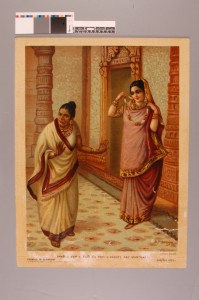Religion as a human creation seeks to answer questions of life as it is, was, and will be. The argument of predestination versus free will has proved to be a metaphysically succulent food for thought, of which many religious lenses have attempted to grasp alas have been unable to prove. Hinduism addresses the concern of predestiny versus free will within the concept of dharma. As researchers, we are concerned with the concrete and real-world effect of dharma and as such the question remains: How does dharma as a traditional value shape modern Hindu ethics?
Dharma, defined as “law plus religion plus morality” (Davis, Jr., 2007), has vast influence on the way in which people form connections through social bonds in order to create society. Traditionally, dharma functioned as a reasoning behind the social hierarchy of castes, or “‘categories’ within which to assign a basically unlimited variety of heterogeneous social entities” (Hiltebeitel, 1987). Modern Hindu social structure continues to explicate the extent of dharma‘s function in terms of caste cohesion and complacency.
Dharma is rooted in Hindu law and ethics as a functional value established by sacred Hindu texts, primarily in the Ramayana. Hess (1999) discusses the relationship between Rama and Sita, key figures in the Ramayana, noting that “the Sita who clung to the dharma of worshipping her husband and bowing to his will, even when he repeatedly and cruelly rejected her, is still embraced as the ideal woman by many Hindus of both sexes. But others, increasingly, are describing that ideal as concocted by and serving the interests of dominant males from ancient times to the present.”
Banerjee, an academically trained artist, painted “Kakaye and Manthara,” a scene from the Ramayana in which Kaikeyi, a supporting character, convinces Manthara, mother of Rama, to exile Rama for fourteen years.
The image illustrates the key moment in which dharma is seen to be counterintuitive to Rama’s betterment. Rama, having godlike moral perception, willingly undergoes such in order to fulfill his dharmic duty of defeating Ravana. The importance of dharma as a moral compass in times of difficulty is a motif in the Ramayana and frequently functions as a method of moral law. Characters who find themselves in times of difficult decisions often act in accordance to their dharma. It is paramount to note that dharma had been historically used to justify caste designation as it is believed that acting in accordance with one’s dharma allows one to “move up” in the next life.
Analyses of dharma in modern Hindu ethics found that dharma as a “tradition is no longer self-evident and [doesn’t have] sufficient justification” (Creel 1975). Lamb (2002) builds upon this, noting that the duty and functions of caste “have gone through a variety of changes during the last millennium, and distances and relationships between the various elements in the hierarchies have changed, [but] the basic structures have not altered significantly.”
Despite the fact that its function in social interactions is no longer instilled nor required, dharma still affects the perception of social caste designation and generates a sense of belonging amongst caste members. Modern Hindu ethics have been operationally defined by the Bharatiya Janata Party (BJP) in the case of its censorship of film production, recognized as a “pursuit of the…voluntary moral standard for the media and the protection of dharma … (in which the BJP) acted both as an instigator and a catalyst for moral panics that served its reactionary cultural agenda of homogenization” (Bose, 2009). In terms of modern legal effects, dharma plays an influential role as a fluid definition which became especially prominent in post-Colonial India:
“The legal side of dharma [had] ironically been lost precisely because the artificial colonial focus on Dharmasastra as legal codes could not be sustained in light of either further investigation of the texts themselves or in the practical context of British colonial courts, both of which demonstrated that Dharmasastra was not a promulgated legal code. …Rather, Dharmasastra contains the theological jurisprudence of Hindu law and the only reasonable basis upon which local legal systems in India can be called Hindu at all.”
The effect of dharma and its influence on modern social structure is thus irrefutable. In regards to Hindu ethics and law, dharma must still play a role in the formation of the cultural norms and values and thus Hindu social values, including that of social hierarchies and the implicit nature of such. Hacker (2006) poignantly summarizes modern dharmic influence as “no longer useful because it contains so much that people no longer want to adhere to today, for example, the fundamental commitment to castes, life-stages, and geographical places. …a new meaning is being given to the word dharma.”
Works Cited
Banjaree, B.P. (1906). “Kakaye and Manthara” [image]. Retrieved from:
http://www.britishmuseum.org/research/collection_online/collection_object_details/collection_image_gallery.aspx?assetId=1041088&objectId=266414&partId=1
Bose, Nandana. “The Hindu Right and the Politics of Censorship: Three Case Studies of Policing Hindi Cinema, 1992-2002” The Velvet Light Trap, No. 63, Spring 2009, pp. 22-33.
Creel, Austin B. “The Reexamination of Dharma in Hindu Ethics.” Philosophy of East and West. (25:2) pp. 161-173.
Davis Jr., Donald R. “Hinduism as a Legal Tradition” Journal of the American Academy of Religion. June 2007, Vol. 75, No. 2, pp. 241-267.
Hacker, Paul “Dharma in Hinduism” Journal of Indian Philosophy, Vol. 34, No. 5 (Oct. 2006), pp. 479-496.
Hess, Linda. (1999). “Rejecting Sita: Indian Responses to the Ideal Man’s Cruel Treatment of His Ideal Wife” Journal of the American Academy of Religion. (67:1) pp. 1-32.
Hiltebitel, Alf. “Hinduism: An Overview” Encyclopedia of Religion, 2nd Edition, ed. Lindsay Jones (Detroit: Macmillan Reference USA, 2005), 3998-4009.
Lamb, Ramdas. Rapt in the Name: The Ramnamis, Ramnam, and Untouchable Religion in Central India (Albany: State University of New York Press, 2002), 1-23.

